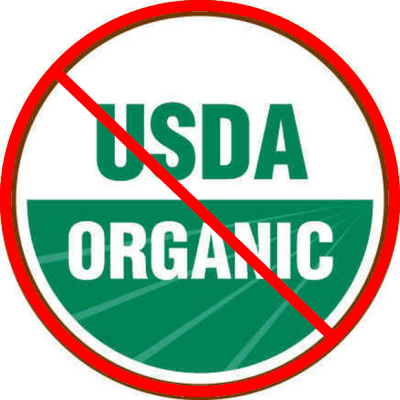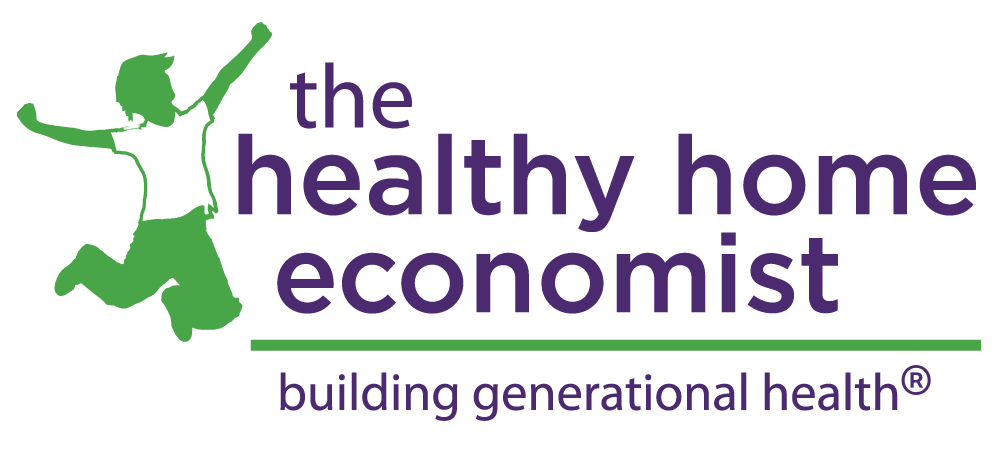 Why would the average consumer decide to switch to organic food? Typical reasons include food of higher quality that is hopefully more nutritious although conventional produce grown locally and picked at the peak of ripeness would no doubt rival the nutrition of organic produce picked early and shipped long distances. Consumers also generally assume that any food labeled as USDA Organic will not contain any dangerous ingredients or chemicals like carrageenan.
Why would the average consumer decide to switch to organic food? Typical reasons include food of higher quality that is hopefully more nutritious although conventional produce grown locally and picked at the peak of ripeness would no doubt rival the nutrition of organic produce picked early and shipped long distances. Consumers also generally assume that any food labeled as USDA Organic will not contain any dangerous ingredients or chemicals like carrageenan.
After all, buying certified organic food is still the only way to avoid genetically modified ingredients as GMOs are regularly slipped into healthfoods labeled as “natural” and even those containing organic ingredients but less than 70% organic overall.
Based on these assumptions, consumers would likely be surprised and even shocked to learn that a likely human carcinogen that triggers massive gastointestinal inflammation and symptoms in many people continues to be allowed by the National Organics Standards Board (NOSB) for inclusion on the list of ingredients permitted in certified organic food – food bearing the USDA Organic label!
This dangerous ingredient, carrageenan, which most consumers are unaware is lurking in so many of their beloved organic products, seems harmless enough at first glance.
Derived from seaweed, carrageenan is a highly processed food additive that has no nutritional function whatsoever.
What it does do is act as a fat replacer or stabilizer in certain types of dairy products, commercial dairy substitutes like soy milk, coconut milk, hemp seed milk, almond milk, and other processed foods.
As you can see, buying lowfat is not a good idea and not just for the fact that you are losing the valuable whole fats that satiate and steady the blood sugar. By opting for lowfat or alternative dairy products, consumers are choosing instead to consume a toxic additive that is a likely carcinogen!
Carrageenan a Potential Carcinogen
Even Dr. Andrew Weil has been telling people about carrageenan dangers since 2002.
Carrageenan is so toxic and inflaming to the human digestive system that this food additive is formally classified by the International Agency for Research on Cancer (part of the World Health Organization) as a potential human carcinogen.
Scientists first discovered that carrageenan causes gut inflammation as far back as the 1960’s. Inflammation is a very serious condition as it is a primary symptom in IBS, Crohn’s Disease, ulcerative colitis, and colon cancer as well as dozens of other diseases.
The hype from the carrageenan industry claims that “food grade” carrageenan is different from the low molecular weight, i.e., degraded carrageenan that is toxic to human cells.
This spin fails to mention that not a single sample of products containing carrageenan that were tested could be said to be free of the degraded form. Some samples contained as much as 25% low molecular weight carrageenan. This testing was conducted as part of a 2003 ruling by the European Commission’s Scientific Committee on Food which required that a maximum of 5% degraded carrageenan be contained in a processed food which includes the additive.
Another problem is that research available since the early 1980’s indicated that even food grade carrageenan is probably converted during the digestive process to the degraded, highly toxic form. More recent research sponsored by the National Institutes of Health (NIH), pinpointed the exact metabolic process by which carrageenan triggers inflammation. Shockingly, this biological event was found to mirror the way pathogenic bacteria such as salmonella wreak havoc in the gut.
The takeaway for consumers from this very discouraging NOSB ruling is to not take anything for granted just because a product is labeled USDA Organic. It still could be extremely damaging to your health!
Avoiding lowfat dairy and processed dairy substitutes is a very wise course of action. If you have a dairy allergy, learn to easily make healthy milk substitutes at home that are free of carrageenan dangers!
Be aware that most commercial pet food is loaded with carrageenan too. Check the labels to be sure your furry friends don’t suffer from its unhealthy effects as well.
Sarah, The Healthy Home Economist
Sources and More Information
The Cultivator, News from the Cornucopia Institute, Summer 2012








I took carageenan out of my diet many years ago. I didn’t discover it for awhile, but just knew I needed all chemicals out of my food. Keeping these things out has been good. I’ve no longer been bothered by aural migraines. I had to track down all forms of msg, which took awhile. It is no longer an issue as far as what I want in my diet. It is more difficult to shop though, even organic foods since it involves label reading if I choose a product I’ve never tried.
People laugh at me and tell me it’s only seeweed. I remember many years ago an entire display at the fair on how wonderful it was, and the kids got to go through a colorful display of items, toothpaste, ice cream etc. and how this product made it so much better for them. That it was so safe, it could be used in your food.
Great! Something else I have to worry about now! This never-ending cycle needs to stop! I am sick of the government playing with my food!
I’ve been working on Trader Joe’s to get them to dump carrageenan from their foods. I was told yesterday that TJ’s doesn’t use any chemicals on their carrageenan and so it’s safe. Oh boy! I explained to the woman while it’s nice they don’t use chemicals the problem is still with the carrageenan itself. Please help me out here and land blast them with the dangers of carrageenan. We need to change the outlets because it seems most people are unaware of this harmful useless additive.
Lisa, I completely agree with your comments and feelings, but I scratched my head at the expression “land blast.” What does she mean, I wondered…”land blast, land blast…” and then it struck me: you must mean “lambast”! I hope you don’t mind me pointing this out. I see more and more of these grammar LOLs because people don’t read much any more, and write what they think they’re hearing. Like my friend who used the expression “pur say,” which, again, had me scratching until I realized she meant “per se.” =) That takes the prize so far.
I guess I won’t make that mistake again. It was a little hurtful though that since I made an error that you assume that I’m not an avid reader. My wonderful dyslexic husband gave me the best advice in life; it’s not all about punctuation and correct spelling but it’s more about getting your point across. What was your point? Shaming me in a public forum? Getting a good laugh?
PS. My husband was made to feel stupid throughout his formative years because he had difficulty reading and writing. Our own children also suffer from learning disabilities and that is what has lead me on this path of health. Even though my hubs can’t spell worth a darn or put a paragraph together very well, he has still managed to become COO of a relatively large company.
Very sorry…shouldn’t have said anything. I should have known it would probably cause offense. I don’t mind if people correct my grammar, since getting it right and also knowing other points of view are very important to me, but I do know I’m in the minority in not being bothered by correction. I proofread and edit almost daily at work, so I don’t see it as an issue of sensitivity. I didn’t really assume you weren’t a reader–I just know that fewer and fewer people like to read now, and it becomes obvious in public forums. That was just a general comment.
Yes, anyone can make a mistake, and I did truly find it funny when I came across an expression I’d never heard before, and puzzled and puzzled over it until finally it hit me. But if I could delete the comment, I would. I consider these comment threads to be quite anonymous, and shaming someone in public is the last thing I’d think of or ever do. However, this exchange will make me resist all future impulses to be helpful with grammar when nobody’s asking. Again, sorry for hurting your feelings.
Diane, I find it remarkable that you would make Lisa’s mistake a point of discussion, and in the manner that you did. I would wager money that you are manipulative and mentally abusive to your loved ones.
David, it’s hard to know how to respond to such an accusation, but I have never heard those words applied to me. You can’t know and judge a person by one short paragraph in an anonymous online forum. I made a mistake, I learned from it, and I will keep all such comments to myself in the future. I really did intend to be humorous and helpful, but I see now it was very naive of me to think it would be taken that way.
Diane, I think the key here is to not “scratch your head” so much over other people’s comments. It could very well be causing the female-pattern-baldness and oozy head warts you said you have under another blog post.
Thanks for posting this, I have always wondered… I used to use almond ‘milk’ because dairy causes some minor upset for me. However, after awhile I grew tired of the creepy ingredient list and decided to just deal with the repercussions of dairy consumption. I find that if I include cultured dairy products throughout the day (a little bit of yogurt, a little bit of cultured cream) then I can enjoy a small amount of raw milk without worry. Now I wonder if my sensitivity to dairy was exacerbated by inflammation from consumption of things like carrageenan in the first place!
Slightly off topic… I have read that USDA organic does allow GMO foods. I haven’t found any good report one way or the other. Where did you find your information?
Organic Valley does actually have a heavy cream that is just pasteurized (NOT the ultra-pasteurized one) that has just one ingredient: “Organic Grade A Cream (Milk).” I actually handle that pretty well.
But I found out when I picked up my milk last week that my farmer is gonna be offering raw cream now! And it’s an awesome price. YAY!
So if this carrageenan is found in seaweed – does eating seaweed negatively affect the person? Or is it only a problem in it’s processed form?
Yes, I’d like to know this too. Like what about sushi and nori? Thanks for reminding of this additive Sarah.
There are two common species of nori: Porphyra yezoensis and Porphyra tenera.The first contains abundant amounts of bonafide vitamin B12, but the second contains large amounts of non-bioavailable pseudovitamin B12 (when dried). So the first nori is good, but the second nori is potentially harmful.
I had read some time ago that carrageenan was not good for you, but it sort of faded into the background—thank you for the reminder! I will have to be more vigilant in reading labels…and cross a few more things off the list.
Go Chia—they are great on just about anything!